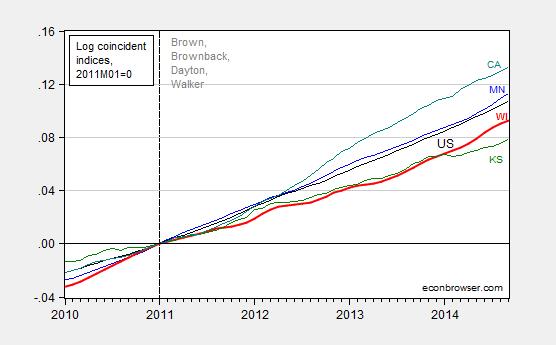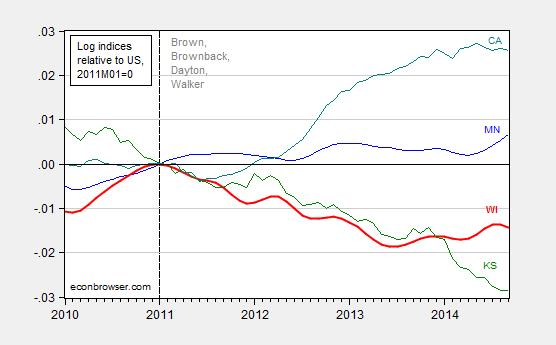Low ranked by ALEC-Laffer, California and Minnesota continue to power along, as shown in data released today by the Philadelphia Fed.
Figure 1: Log coincident indices for Minnesota (blue), Wisconsin (bold red), Kansas (green), California (teal), United States (black), seasonally adjusted, all normalized to 2011M01=0. Source: Philadelphia Fed and author’s calculations.
Another way of visualizing the data is to show the cumulative growth relative to that of the United States. This is shown in Figure 2.
Figure 2: Log coincident indices for Minnesota (blue), Wisconsin (bold red), Kansas (green), California (teal), seasonally adjusted, all expressed relative to that of the United States and normalized to 2011M01=0. Source: Philadelphia Fed and author’s calculations.
Some observers have argued that Wisconsin’s poor performance is attributable to regional shocks; if so, it is strange that Minnesota — Wisconsin’s next door neighbor — has failed to evidence a similar slowdown relative to the United States. In addition, econometric analysis of the ratio of Minnesota to Wisconsin real per capita Gross State Product indicates that the Walker administration coincides with a structural break — i.e., Wisconsin GSP per capita growth declines relative to Minnesota’s (see this post). This could be entirely coincidental, or it could be a function of policy (see yesterday’s post).
Bruce Bartlett brought my attention reminded me a few days ago to the newly releasedof the ALEC-Laffer 2014 rankings in “Rich States, Poor States” (Table 1, page 68); Kansas and Wisconsin are 15th and 17th, while Minnesota and California are 46th and 47th. In other words, RSPS’s ALEC-Laffer ranking continues to have a negative correlation with growth. (For an econometric — cross-section — evaluation, see this post).


I wonder if these redundant surveys by Professor Chinn, of Kanconsin
and Minnfornia will end after the elections?
Hans: I dunno; will you ever stop calling the Heritage Foundation conceived ACA “CommieCare”?
Professor Chinn, I certainly indeed have issues with the Hermitage Foundation and
their lack of faith in the the free markets, by sponsoring RomneyCare.
They lost a great deal of credibility by co-opting the freedom of choice.
We have abortions based on the freedom of choice but not health care plans.
Funny, how the ethos system for the left works, including Mitty Romney.
hans, just to be clear, you support freedom of choice. or do you choose when/where that right may be permitted?
of course, the ACA has been declared a tax by the conservative supreme court. are you advocating we also can choose to pay taxes or not?
Buffling, the less than Conservative High Court, should mandate home fire sprinklers
via a tax, would that also also be constitutional or sane?
Injustice Roberts, decided not to overturn major legislation by the court, rather
he thought it best that Americans learn an economic lesson on how badly most
governmental units programs are.
BTW, 70% of all California doctors will not partake in KennedyCare and over 25%
of all doctors nationally will not take ComieCare patients.
http://cnsnews.com/mrctv-blog/barbara-boland/over-214000-doctors-opt-out-obamacare-exchanges
ALEC-Laffer can not fail they can only be failed. Just you wait, Kansas and WI will be shooting to the moon soon. Define soon?
Menzie, not to bust your chops but, I’ll claim a little credit on bringing the “Rich States, Poor States” analysis (although in using that term I realize that you need to contort the meaning of “analysis” into a concept that actually can best be described as “anti-analysis”) to your attention in my comment on that blog post, which is still, however, quite valid (IMHO).
“Thanks Menzie, another great reality-based critique. Unfortunately, the Laffer/ALEC analysis, while it purports to be about the relationship between taxes, et. al. to growth, is really just a cheerleading document for their preferred policy regime. Therefore, it is not a surprise that no relationship can be found–and this paradox just reflects the point that in order to advance ALEC’s political agenda, the results almost require a lack of relationship. For example, does anyone in Wisconsin seriously think that the state has jumped from 33/34th to 17th in growth potential? Has a pool of oil beneath the state been discovered recently? (pretty tough since the rocks are all of Pre-Cambrian origin) Has the state begun to swell with immigrants? (even the ALEC study itself reported a net out-migration) My point is that the pressure was on ALEC to praise Walker by claiming that Wisconsin was facing a bright future. No doubt the “fact” that the state’s rating by ALEC has jumped will appear in future political ads, but does anyone, anywhere in the state expect this upsurge in economic activity? Moody’s certainly doesn’t, but then Moody’s is writing for people who need accurate information to allocate billions of dollars in financial resources–quite a different standard.”
Dr. Morbius: I didn’t mean to imply that Mr. Bartlett was the first to bring my attention to RSPS — you have my full appreciation for that. I merely meant that he had alerted me to the new release of RSPS 2014.
Dr. Morbius: I stand corrected; RSPS 2014 has been out for a while, so Bruce just reminded me of the sheer stupidity of RSPS, which you alerted me to.
Does anyone know how much of the variance can be explained by structural differences in each state’s economy?
Mike See Menzie’s post from 23 April. See the “this post” hyperlink at the very end of his post. It will take you there. He used changes in growth rates to account for fixed effects; i.e., structural differences.
Rich states become richer, to a large extent, because of labor mobility.
It becomes a virtuous cycle.
It’s more accurate to look at neighborhoods, for example.
Who are the rich, the middle class, and the poor?
Does anyone know of a governor who has been forced into three elections in four years, a shut down of government because a party ran out of the state, and a witch hunt, secret, politically motivated, illegal (as ruled by the court) investigation that has not stopped even thought the courts have so ordered? The progressives become “Chicago” deadly when they see their confiscated loot slipping from their hands.